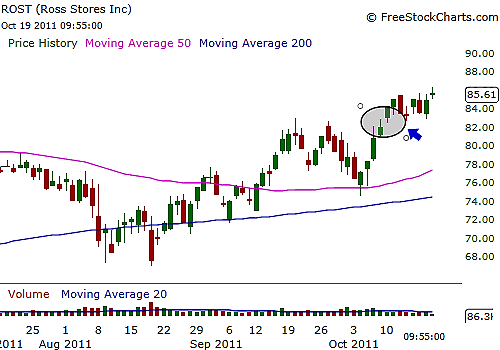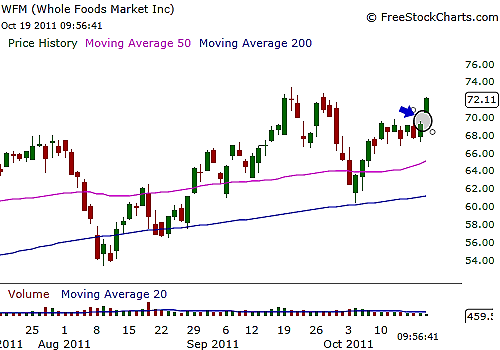
HOT TOPICS LIST
- MACD
- Fibonacci
- RSI
- Gann
- ADXR
- Stochastics
- Volume
- Triangles
- Futures
- Cycles
- Volatility
- ZIGZAG
- MESA
- Retracement
- Aroon
INDICATORS LIST
LIST OF TOPICS
PRINT THIS ARTICLE
by Billy Williams
Don't look at volume now to spot emerging bullish trends or you'll miss the next big move.
Position: Buy
Billy Williams
Billy Williams has been trading the markets for 27 years, specializing in momentum trading with stocks and options.
PRINT THIS ARTICLE
TECHNICAL ANALYSIS
Spotting Accumulation In A Quiet Market
10/20/11 10:48:03 AMby Billy Williams
Don't look at volume now to spot emerging bullish trends or you'll miss the next big move.
Position: Buy
| Currently, stocks are slow to show any signs of strength to the upside despite the trend reversal in the overall markets. While it is likely that there is some hesitation on the part of investors and traders to get back into the market at this early stage, it is worth noting that the larger forces responsible for moving the markets such as mutual funds and institutional trading firms may be moving stealthily to enter new positions to the long side without alerting the investment community. Value investors, in particular, look to add to winning positions during the downturn because they see the decline in price less of a function of the external value of the going share price versus the intrinsic value of the share price in relation to the existing fundamentals of the company itself. |

|
| FIGURE 1: ROST. ROST is a retail operation that has maintained its price above the 50-day simple moving average (SMA) and 200-day SMA while recently signaling an entry. This signal does not require a rise in volume as a confirmation and could indicate that this leader is under accumulation. |
| Graphic provided by: www.freestockcharts.com. |
| |
| During these times of market decline, value investors and value mutual funds look to pull the trigger and add what they believe to be undervalued securities to their portfolios. Growth investors, however, look to stocks that are expanding in sales as well as the scope of their operations through aggressive capturing of market share and ever-increasing sales. In downturns, they are less likely to buy stocks that are believed to be undervalued in relation to a company's fundamentals. They are more likely to buy undervalued assets of a company they believe is expanding in the magnitude of a given market or determined to be on the cusp of developing a new market where they have a distinct competitive advantage. Trading volume is then one of the most reliable methods to determine whether a stock is under accumulation by a big institution. Skilled traders like you are watching closely for any signs of a stock being snapped up by a major player. The problem is that the major players are aware that a given security is being tracked and if they are not careful in how they accumulate shares, it will send a signal to the rest of the trading community. This will cause a spike in a share's price and they will have to end up paying more for their position than they intended. |

|
| FIGURE 2: WFM. WFM is an impressive leader in its field and the stock market. Despite low trade volume, a gap entry was signaled recently, which does not require high volume to confirm its signal. Like ROST, stock leaders appear to be emerging in similar patterns, which could indicate that accumulation is under way, followed by a strong bullish run. |
| Graphic provided by: www.freestockcharts.com. |
| |
| Eventually, volume will tell the tale of what is going on, but there is another way to watch for quiet stocks that are about to begin a strong move to the upside, which is looking for a plurality of patterns. The plurality of patterns concept was first detailed by Mark Boucher, a sometime S&C contributor, a hedge fund manager, and author of "The Hedge Fund Edge." The book explained that his studies revealed that quiet markets begin to mirror each other by forming similar patterns. |
| While volume may not reveal accumulation in a given stock (Figure 1), you can look for similar themes in a stock's price action, such as chart patterns and entry signals across a spectrum of stocks or "cousin stocks," where stocks in the same industry are not sector leaders but mirror the price action of the current stock leader. See Figure 2. |
| The earlier you can get in on a particular move, the more money you will make, but this is especially true during the first initial thrust in the direction of the trend. Waiting for a lagging signal can help you enter a move but you would have to suffer through the common back-and-forth trading that follows as latecomers pile on their positions while market-makers take the other side for quick profits. This concept can give you a fresh perspective to assess opportunities in the market and help you single out winning trades, while others stare blankly at their computer screens waiting for something to happen, unaware that something already is happening. |
Billy Williams has been trading the markets for 27 years, specializing in momentum trading with stocks and options.
| Company: | StockOptionSystem.com |
| E-mail address: | stockoptionsystem.com@gmail.com |
Traders' Resource Links | |
| StockOptionSystem.com has not added any product or service information to TRADERS' RESOURCE. | |
Click here for more information about our publications!
Comments

|

Request Information From Our Sponsors
- StockCharts.com, Inc.
- Candle Patterns
- Candlestick Charting Explained
- Intermarket Technical Analysis
- John Murphy on Chart Analysis
- John Murphy's Chart Pattern Recognition
- John Murphy's Market Message
- MurphyExplainsMarketAnalysis-Intermarket Analysis
- MurphyExplainsMarketAnalysis-Visual Analysis
- StockCharts.com
- Technical Analysis of the Financial Markets
- The Visual Investor
- VectorVest, Inc.
- Executive Premier Workshop
- One-Day Options Course
- OptionsPro
- Retirement Income Workshop
- Sure-Fire Trading Systems (VectorVest, Inc.)
- Trading as a Business Workshop
- VectorVest 7 EOD
- VectorVest 7 RealTime/IntraDay
- VectorVest AutoTester
- VectorVest Educational Services
- VectorVest OnLine
- VectorVest Options Analyzer
- VectorVest ProGraphics v6.0
- VectorVest ProTrader 7
- VectorVest RealTime Derby Tool
- VectorVest Simulator
- VectorVest Variator
- VectorVest Watchdog
